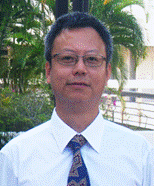主讲人:Hua Zhang教授
时间: 2018年11月9日上午10:10
地点: 深圳大学西丽校区420会议室

报告人简介:
Dr. Hua Zhang obtained his B.S. and M.S.degrees at Nanjing University in China in 1992 and 1995, respectively, andcompleted his Ph.D. with Prof. Zhongfan Liu at Peking University in China inJuly 1998. He joined Prof. Frans C. De Schryver’s group at KatholiekeUniversiteit Leuven (KULeuven) in Belgium as a Research Associate in January1999. Then he moved to Prof. Chad A. Mirkin’s group at Northwestern Universityas a Postdoctoral Fellow in July 2001. He started to work at NanoInk Inc. (USA)as a Research Scientist/Chemist in August 2003. After that, he worked as aSenior Research Scientist at Institute of Bioengineering and Nanotechnology inSingapore from November 2005 to July 2006. Then he joined the School ofMaterials Science and Engineering in Nanyang Technological University (NTU) asan Assistant Professor. He was promoted to a tenured Associate Professor onMarch 1, 2011, and Full Professor on Sept. 1, 2013.
He has published 5 invited book chapters,73 patent applications (including 8 granted US patents and 1 Singapore patent),and over 450 papers, among which 203 papers were published in IF>10 journalsand 103 papers were published in 8<IF<10 journals. Some of his papershave been published in Science (1), Nat. Chem. (5), Nat. Catal. (1), Nat. Rev.Mater. (2), Nat. Commun. (8), Sci. Adv. (1), Nat. Protocols (1), Chem. Rev.(2), Chem. Soc. Rev. (12), Acc. Chem. Res. (2), J. Am. Chem. Soc. (16), Angew.Chem. Int. Ed. (28), Adv. Mater. (51), Chem (1), Energy Environ. Sci (12),Mater. Today (1), Adv. Energy Mater. (6), ACS Nano (29), Nano Lett. (14), Adv.Funct. Mater. (4), Nano Energy (4), Mat. Horizons (2), ACS Catal. (1), etc.Based on Web of Science on Oct. 22, 2018, the total citation times of hispapers are over 52,600 with H-index of 114. He has been invited to give morethan 300 Plenary, Keynote or Invited Talks in international conferences,universities and institutes, and serve as the Session Chair. He has organizedseveral tens of international conferences and served as the Symposium Chair orConference Co-Chair. He is one of three Chairmen of the Editorial Board ofChemNanoMat (2015-), sits on the Advisory Board of Chem. Soc. Rev. (2012-), NPGAsia Materials (2018-), Nanoscale (2012-), Nanoscale Horizons (2015-) andMaterials Chemistry Frontiers (2016-), the Editorial Advisory Board of ACS Nano(2014-), Chem. Mater. (2014-), ACS Appl. Mater. Interfaces (2014-), Small(2012-), and Nanofabrication (2012-), the Editorial Board of CHEM (2016-),Carbon (2013-), Applied Materials Today (2015-), Energy Storage Materials(2015-), EnergyChem (2018-), ACS Omega (2016-), Materials Today Energy (2016-),npj 2D Materials and Applications (2016-), NANO (2007-), Chinese ScienceBulletin (2014-), Science China Materials (2014-) and Graphene Technology(2016-), and the International Advisory Board of Materials Research Express (2014-)and ChemPlusChem (2012-2015). He is also one of the members of the AdvisoryCommittee of IOP Asia-Pacific (2010-). In 2015, he was elected as anAcademician of the Asia Pacific Academy of Materials (APAM). In Nov. 2014, hewas elected as a Fellow of the Royal Society of Chemistry (FRSC). In 2016, hewas listed in the top 300 most cited researchers in the field of materialsscience and engineering (Elsevier Scopus). In 2015-2018, he was listed in the"Highly Cited Researchers" in Chemistry and Materials Science(Thomson Reuters). In 2015, he was listed as one of 19 “Hottest Researchers ofToday” in the world in the World’s Most Influential Scientific Minds 2015(Thomson Reuters, 2015). In 2014, he was listed in the "Highly CitedResearchers 2014" in Materials Science, and also listed as one of 17“Hottest Researchers of Today” and No. 1 in Materials and More in the world inthe World’s Most Influential Scientific Minds 2014 (Thomson Reuters, 2014).Moreover, he got the Young Investigator Award (Young Giants of Nanoscience2016, Hong Kong), Vice-Chancellor’s International Scholar Award (University ofWollongong, Australia, 2016), ACS Nano Lectureship Award (2015), World CulturalCouncil (WCC) Special Recognition Award (2013), the ONASSIA Foundation Lectureship(Greece, 2013), Asian Rising Stars (15th Asian Chemical Congress, 2013), SMALLYoung Innovator Award (Wiley-VCH, 2012) and Nanyang Award for ResearchExcellence (2011).
Dr. Zhang’s research is highlyinterdisciplinary. His current research interests focus on the (crystal-)phaseengineering of nanomaterials and controlled epitaxial growth ofheterostructures, including the synthesis of ultrathin two-dimensionalnanomaterials (e.g. metal nanosheets, graphene, metal dichalcogenides,metal-organic frameworks, covalent organic frameworks, etc.), novel metallicand semiconducting nanomaterials, novel amorphous nanomaterials and theirhybrid composites, for various applications such as catalysis, clean energy,(opto-)electronic devices, nano- and biosensors, and water remediation.
讲座摘要:
In this talk, I will summarize the recentresearch on the phase engineering of nanomaterials in my group. It includes thefirst-time synthesis of hexagonal-close packed (hcp) Au nanosheets (AuSSs) ongraphene oxide, the first-time synthesis of 4H hexagonal phase Au nanoribbons(NRBs), the synthesis of crystal-phase heterostructured 4H/fcc Au nanorods, theepitaxial growth of metals with novel phases on the aforementioned Aunanostructures, and the synthesis of amorphous/ crystalline hetero-phase Pd nanosheets.In addition, the first-time synthesis of 1T'-MoS2 and 1T'-MoSe2 crystals havebeen achieved. Moreover, the phase transformation of transition metaldichalcogenide nanomaterials during our developed electrochemicalLi-intercalation method will also be introduced. Interestingly, thelithiation-induced amorphization of Pd3P2S8 is also achieved. Currently, mygroup focuses on the (crystal) phase-based properties and applications incatalysis, surface enhanced Raman scattering, waveguide, photothermal therapy,chemical and biosensing, clean energy etc., which we believe are quite uniqueand very important not only in fundamental studies, but also in practicalapplications. Importantly, the concepts of crystal-phase heterostructures andhetero-phase nanomaterials are proposed.
欢迎有兴趣的师生参加!
